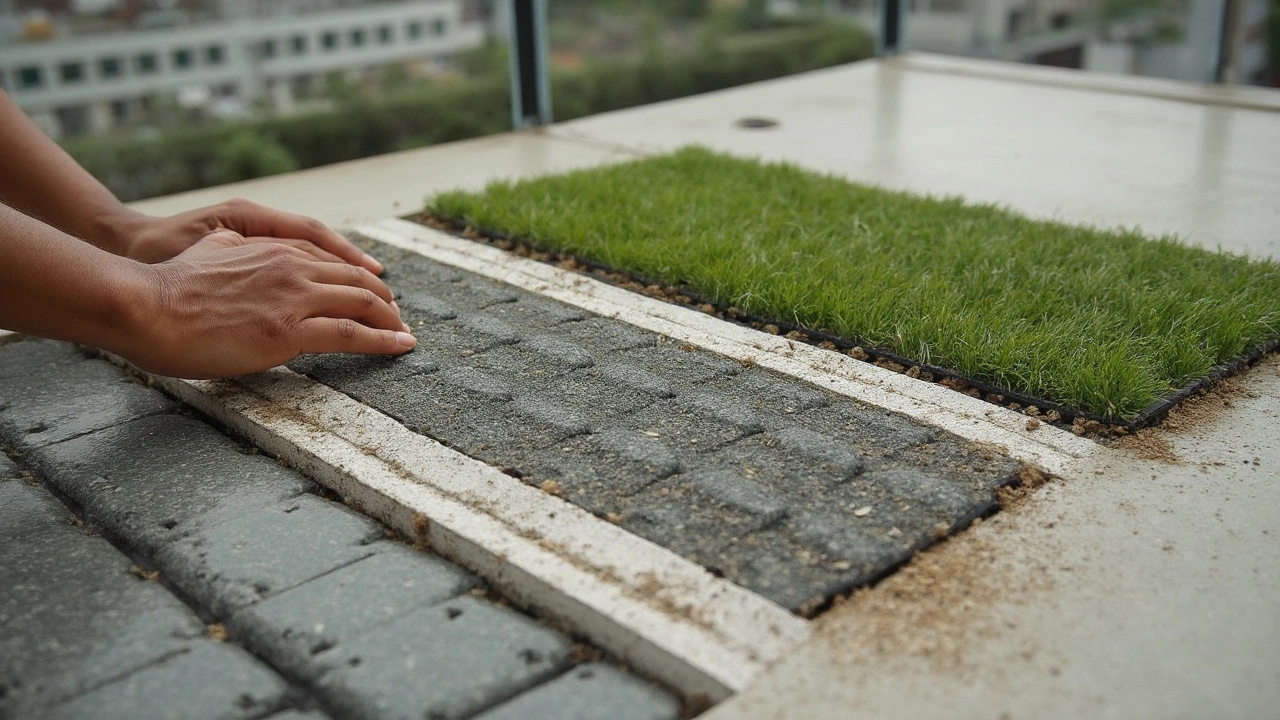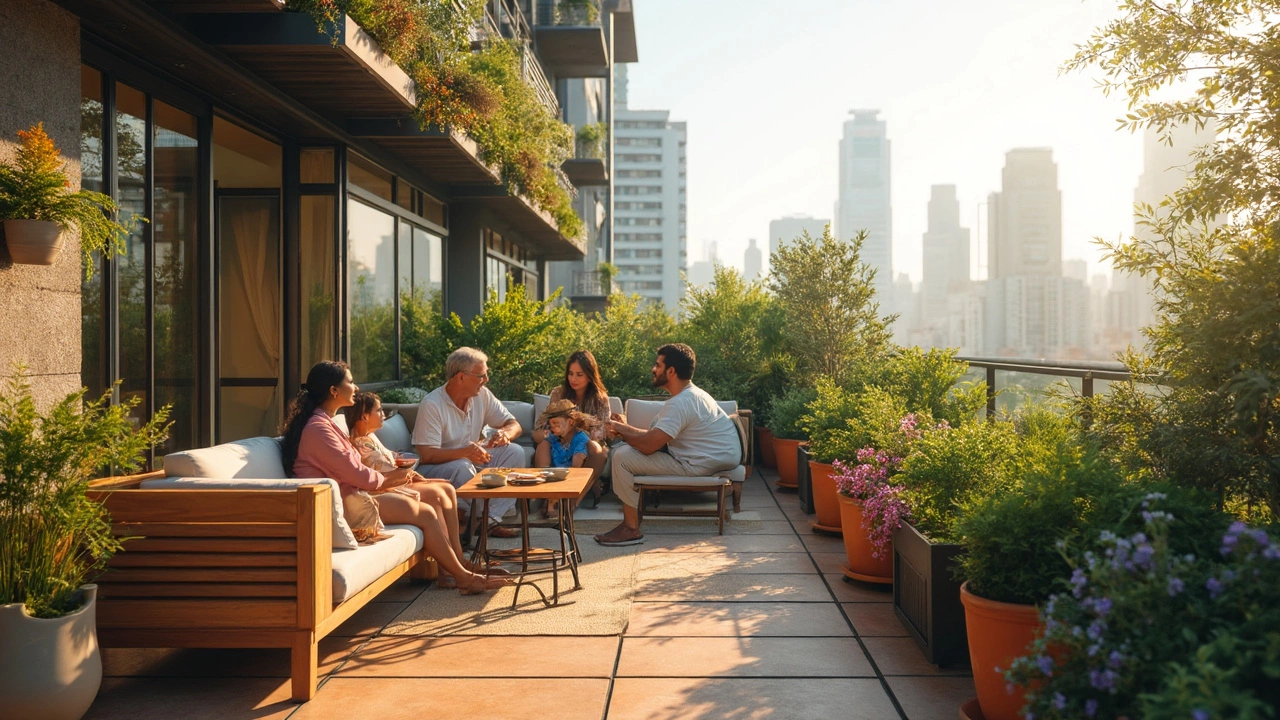Ever step onto a sizzling hot terrace and instantly regret not wearing shoes? Yeah, me too. The right surface for your roof terrace can make or break your whole outdoor vibe—not just for summer hangouts, but for your plants too. One wrong move and you’ll end up with cracked tiles or puddles right where you set up your favorite chair.
People often get stuck between what looks good and what actually works in real life. Some surfaces get dangerously slippery when wet, others turn your terrace into an oven by noon. And then there’s drainage—skip thinking about it, and you’ll get swampy corners or, worse, a visit from your not-so-happy downstairs neighbor.
The good news? There are surfaces that balance style, comfort, and practicality. Whether you’re growing tomatoes, letting your dog nap in the sun, or just want a safe spot to sip your coffee, your surface choice changes everything. Let’s break down options and tricks that actually work—because nobody wants to spend their Saturday scrubbing moss off neglected decking.
- Why Surface Choice Matters
- Most Popular Roof Terrace Materials
- Weather Resistance and Safety
- Drainage and Plant Health
- Budget and Maintenance Tips
- Personal Touch: What Works for Real People
Why Surface Choice Matters
Most people don’t realize how much the roof terrace surface affects daily life—until the weather turns, something cracks, or you end up shelling out for repairs. Choosing the right material isn’t just a style choice; it shapes safety, plant health, comfort, and even home value.
Start with safety. In the UK, surfaces on roof terraces must have slip resistance ratings above 36 PTV (Pendulum Test Value) when wet, especially if the space is used by kids or pets. Cheap ceramic tiles drop below this very quickly after a rain or morning dew—no one needs a wipeout while watering tomatoes.
Temperature is another dealbreaker. Pale or composite surfaces tend to stay much cooler under the sun than dark stone or unpainted concrete, dropping summer surface temps by up to 15°C (according to studies from the University of Bath). If you’ve ever watched your dog back up from a sunbaked patch, you know how real this problem can get.
| Surface Type | Average Surface Temp at 28°C Air Temp | Common Issues |
|---|---|---|
| Concrete (dark) | 51°C | Cracks, too hot |
| Wood/Composite Decking | 38°C | Moss, splinters |
| Porcelain Tiles | 43°C | Slippery when wet |
| Artificial Grass | 35°C | Flattened, tricky drainage |
Drainage is more important than people think—plants drown quick, and flooding risks the roof itself. The ideal surface lets water run off without forming puddles or blocking access to drains. Even with potted plants, water collects fast under flat surfaces like tile, leading to mold and the smell nobody wants to admit to their guests.
And don’t forget, the wrong surface makes cleaning a headache. Porous stone sucks up dirt, moss clings to untreated timber, while smooth decking or tiles are a quick sweep or hose-down job. If you plan on using your terrace a lot, this stuff actually matters—especially after a muddy day with Rufus.
Pick the wrong surface, and you’ll spend more money, more time, and deal with more annoyances. Take a few minutes to compare, and you get a terrace you’ll actually enjoy all year, not just in your Instagram feed.
Most Popular Roof Terrace Materials
People spend hours looking at pictures, but when it comes to actually picking a material for your roof terrace, the top choices come down to a handful that get the job done and won’t drive you crazy with upkeep. Each material has its pros and quirks, so let’s run through the ones you see the most and why people keep coming back to them.
- Wood Decking: Still a classic. It looks warm and natural, pretty much suits any plant you throw on it. The hitch? Maintenance. Wood needs sealing or oiling every year if you want it to last. Go for hardwoods like ipe or teak — these outlast softer woods by a mile.
- Composite Decking: Outsmarted the weakness of regular wood. It’s made from sawdust and recycled plastic mixed together. That means it doesn’t splinter, stain, or rot. No splinters in your feet, and no endless sanding. Slightly more expensive up front, but way less hassle down the road.
- Outdoor Tiles: Porcelain and ceramic tiles designed for outside stand up to rain and sun like champs. They come in about a million designs, from fake wood to smooth stone. Just make sure they’re rated for outdoors—indoor tiles crack and get seriously slippery.
- Pavers: Concrete or stone pavers keep things cool underfoot and tough out harsh weather. They’re heavy-duty and ideal if you’re growing lots of plants in big containers. Bonus: you can lift and replace them if something goes wrong.
- Artificial Grass: Sounds weird for a roof, but people love that barefoot-friendly feel. Modern turf drains water fast, never needs mowing, and looks fine year-round. Great for dogs or kids, but avoid the really cheap stuff—it gets mangled fast.
- Rubber or Foam Mats: These are built for comfort and safety. Easy to install, no need for pro tools. You see them on family-friendly terraces or spots where you need grip (like near a plunge pool).
Here’s a quick summary of the main materials, so you can compare:
| Material | Lifespan (Years) | Maintenance | Weather Resistance | Price (per sq.ft.) |
|---|---|---|---|---|
| Wood Decking | 10-25 | Medium to high | Good, if sealed | $8-$15 |
| Composite Decking | 25-30 | Low | Excellent | $10-$20 |
| Outdoor Tiles | 20-25 | Low | Excellent | $8-$18 |
| Pavers | 20-50 | Low | Excellent | $5-$15 |
| Artificial Grass | 10-15 | Low | Good | $5-$12 |
| Rubber/Foam Mats | 5-8 | Very low | Good | $3-$8 |
With this breakdown, you can match your choice to whatever suits your style, budget, and energy for maintenance. Some folks even combine two materials for zoned spaces—like composite decking for lounging and a patch of turf for pets or play.
Weather Resistance and Safety
Let’s talk about why your terrace surface needs to hold up against everything the sky throws at it. Rain, blazing sun, freezing nights—above your head, it’s all fair game. If your floor can’t take the heat or the wet, you’re going to be fixing cracks and slipping all over the place.
Certain materials just last longer. For example, composite decking and porcelain tiles are famous for not fading or warping, even after years of sun and rain. Natural wood looks cool but is high maintenance—think oiling and sealing once or twice a year to stop rot and splinters. Concrete pavers and outdoor tiles score high for toughness. Artificial grass holds up to downpours and scorching days, but cheap stuff melts or gets moldy fast, so don’t cut corners.
Don’t ignore slip resistance. Floors get scary fast when wet—especially smooth stone, polished tiles, and cheap plastics. The Goldilocks zone is a texture with enough grip that Rufus (my dog) and your toddler can storm through without a wipeout. Porcelain and modern composites usually come with anti-slip finishes. Always ask for slip ratings (look for at least R11 for outdoor terraces).
Here’s a quick cheat sheet comparing weather resistance and safety of some common terrace surfaces:
| Surface Type | UV Resistance | Slip Resistance | Freeze-Thaw Tolerance | Common Problems |
|---|---|---|---|---|
| Composite Decking | High | Good (with right texture) | Excellent | Heavy; needs support |
| Porcelain Tiles | Excellent | Very Good (R11+ rating) | Excellent | Can chip at edges |
| Natural Wood | Fades over time | Fair (can splinter/slip if wet) | Moderate | Needs regular sealing |
| Concrete Pavers | Good | Good (textured) | Excellent | Heavy, can crack if not laid right |
| Artificial Grass | Varies (check UV rating) | Very Good | Excellent | Cheap brands fade/melt |
For roof terraces, don’t pick based on looks alone. The safest bets are surfaces proven to handle sun, storms, and late-night spills. If you go with tiles, double-check they’re frost-proof and non-slip. For deck boards, composite is low-fuss, but make sure the subframe is built to last, too.

Drainage and Plant Health
If you want your roof terrace to be a pleasant spot year-round, you can’t ignore drainage. Rooftop surfaces, especially in cities, don’t get the benefit of natural soil that soaks up water. Standing water not only damages your surface but can wreck planters, drown roots, and bring on the dreaded green slime. A study from the University of Sheffield found that poor drainage can cut the lifespan of roof gardens in half.
What actually works? First, go for surfaces that don’t trap water. Decking with gaps, open-joint tiles, or rubber pavers with built-in channels let rain run through. Avoid using standard indoor tiles—they act like little bathtubs. Lightweight gravel is another reliable trick; water slips right through and it’s easy to replace if needed.
If you’re adding greenery, layer your planters with drainage material. Start with broken terracotta, gravel, or even packing peanuts at the bottom before adding soil. Always check that your containers have holes—no holes means dead plants, no matter how fancy the pot looks.
Some people overlook the slope of the terrace. You’ll want about a 1-2% slope—just enough so water runs off, but not so much it makes your chairs wobbly. Got drainage outlets? Keep them clear! Leaves and debris quickly block them, especially after a storm or if your dog sheds like Rufus does in spring.
Here’s a quick reference to help pick the right setup:
| Surface Type | Drainage Score | Best For |
|---|---|---|
| Composite Decking (gapped) | Excellent | Frequent rain, lots of pots |
| Rubber Tiles (perforated) | Great | Kids, pets, all-weather use |
| Outdoor Ceramic Tiles (unglazed/slatted) | Medium | Sunny, low-rain areas |
| Artificial Grass with Drainage Mat | Good | Play, lounging, light gardening |
| Natural Stone (sealed, not polished) | Medium-Low | Entertaining |
Don’t let a pretty surface fool you. If water’s got nowhere to go, your fancy terrace will turn ugly fast. Bonus tip: every four months, walk your terrace after heavy rain and check if any area pools water. Fix it early, and your plants (and shoes) will thank you.
Budget and Maintenance Tips
When it comes to picking the best surface for a roof terrace, money and maintenance play a huge role—maybe more than style. Surface materials vary a lot in both upfront price and long-term hassle. For anyone looking to keep costs down without headaches, here's what truly matters.
First up, let's talk numbers. Check out this quick side-by-side for popular terrace options. These are average prices per square meter (2024 data, UK domestic market):
| Surface | Upfront Cost (£/m²) | Yearly Upkeep (£) |
|---|---|---|
| Concrete Pavers | £30–£60 | £10 |
| Wood Decking | £40–£90 | £25 |
| Composite Decking | £70–£120 | £8 |
| Outdoor Tiles | £50–£100 | £5 |
| Artificial Grass | £20–£60 | £5 |
Concrete pavers and artificial grass are cheap to lay but might not hold up well if you’ve got kids, pets, or lots of foot traffic. Wood decking looks warm and classic, but between yearly staining and slippery algae, it keeps you busy. Composite decking stays looking fresh with barely any effort—just an occasional wash with soapy water.
Maintenance means more than cleaning. If your terrace faces real weather (rain, ice, pollen, bird droppings), here's how to keep it easy:
- Concrete pavers: Spray them off once a month and sweep debris to prevent moss.
- Wood decking: Clean twice a year, plus a yearly treatment with oil or sealer to avoid splinters.
- Composite decking: Needs just water and mild soap—skip the yearly stains and oils.
- Outdoor tiles: Pressure-wash every four months. Check grouts yearly for cracks.
- Artificial grass: Rake off leaves and hose it down every few weeks if pets use it.
According to garden designer Zara Scales, "Durability always trumps looks if you want your terrace to last. Low-maintenance options may cost more upfront, but they almost always win out when you factor labor and long-term repairs."
Bottom line: Don't skimp on installation, especially for drainage. A badly laid but cheap surface is the fastest way to waste money. If you want the best deal, choose sturdy materials that match your foot traffic and climate, and always ask about the warranty—five years or more is a solid benchmark for outdoor flooring.
Personal Touch: What Works for Real People
Talking with folks who actually use their roof terraces every week, you get straight answers—what holds up, what doesn't, and which surfaces have you cursing during a sudden rainstorm. Nobody wants to spend every weekend power-washing slippery tiles or panicking about splinters with bare feet. Here's what real terrace gardeners and city dwellers say really works.
Composite decking comes up a lot. It doesn't rot, it's easy to clean, and dogs (yep, like Rufus) won't tear it up as easily as wood. It also doesn’t soak up as much heat as dark tile, so you’re less likely to scorch your feet. One New York rooftop gardener said her composite boards still looked good after three sweltering summers, even with pots and a mini-urban jungle on top.
Porcelain or ceramic tiles get points for looking sharp and being super low-maintenance. Look for ones with a textured finish—slippery tiles are a terrible surprise with the first rain. Plus, a textured finish helps hide dirt and scuffs from chair legs or heavy planters.
Some people swear by artificial grass, especially if you want a softer vibe or have pets. It’s shockingly simple to clean (just hose down) and drains well if you do it right. But, go for UV-resistant kinds, or it’ll fade after a year or two in full sun. Here's a quick breakdown of how common surfaces stack up in real-world use:
| Surface Type | Average Lifespan | Heat Retention | Maintenance Required | Pet & Kid Friendly |
|---|---|---|---|---|
| Composite Decking | 15-25 years | Low | Low | Yes |
| Porcelain Tiles | 20+ years | Medium | Low | Yes (with texture) |
| Artificial Grass | 8-15 years | Low-Medium | Very Low | Yes |
| Wood Decking | 7-15 years | Medium | High | Maybe (splinters) |
| Concrete Pavers | 20+ years | High | Medium | Yes (can get hot) |
If you’re doing it yourself, here are a few musts:
- Make sure your surface is slip-resistant (wet feet and smooth tile = trips to urgent care).
- Test a sample for heat: leave it in the sun at noon, then step on it barefoot. Seriously—it’s the easiest test you’ll do all year.
- Focus on drainage to keep roots happy and surfaces dry. Raised tiles or decking with gaps work wonders.
- Factor in heavy planters and foot traffic—lighter materials sometimes dent or mark easily.
Pick durability and safety over the trendy look you just saw in a magazine. The roof terrace that’s comfy for people (and Rufus), is the one you’ll actually use, rain or shine.

